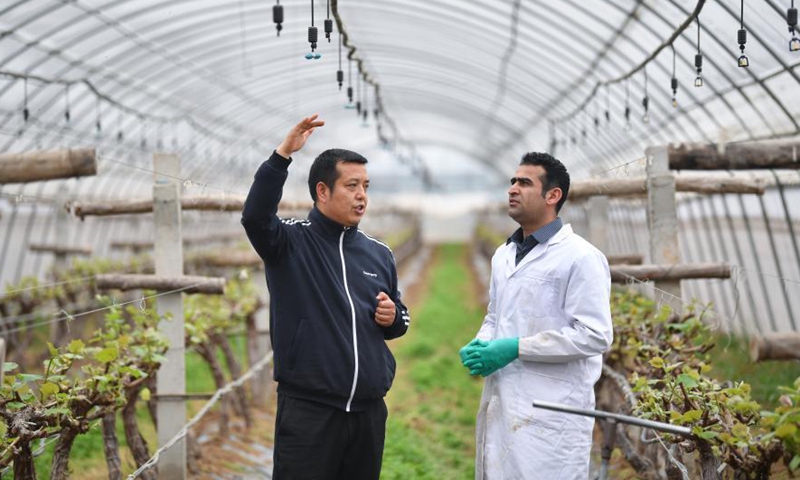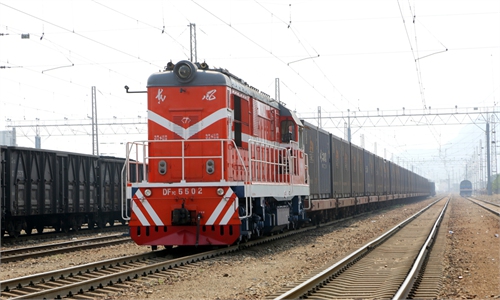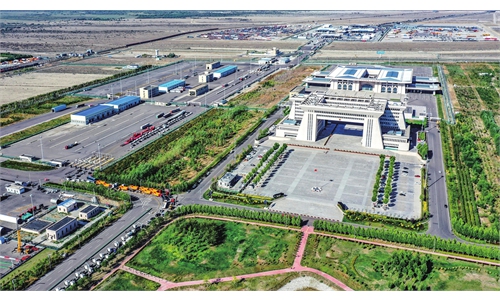China-Central Asia agricultural cooperation under SCO framework contributes to regional, global grain security
Multiple highlights contribute to regional, global grain security and supply chain stability

Experts work on irrigation equipment at a cooperative of Yangling agricultural hi-tech industrial demonstration zone in Northwest China's Shaanxi Province. File photo: Xinhua
China's agricultural cooperation with Central Asia, which is considered to be a core region of the Shanghai Cooperation Organisation (SCO), has been moving forward steadily with greater breadth and depth in recent years, according to Chinese agricultural experts and representatives from the SCO agriculture cooperation base.
They listed multiple cooperation highlights ranging from traditional agricultural trade, seed technology innovation, saline-alkali land and arid and semi-arid areas development, to water-saving irrigation and joint talent cultivation.
The comment was made ahead of Shanghai Cooperation Organization (SCO) summit, which will take place in Astana, Kazakhstan in early July.
As agriculture is one of the earliest fields in which SCO members established a cooperation mechanism, the fruitful results underscore the constructive role the SCO could play in stabilizing agricultural markets and ensuring regional and global grain security, as well as maintaining the smooth flow of supply chains, industry observers said. It also sheds light on the abundant potential for deepening cooperation between the two economies, which analysts said is based on a high level of mutual trust and the joint vision to build a closer China-Central Asia community with a shared future.
Under the SCO framework, Chinese companies and universities have set up around a dozen agricultural demonstration bases with local peers across Central Asia, such as on grain and oil crop production as well as the improvement of saline-alkali land in Kazakhstan, Ma Jing, deputy executive director of the Office for Agricultural Technology Exchange and Training Demonstration Base under the SCO, told the Global Times.
In particular, the Yangling SCO Agricultural High-Tech Industry Demonstration Zone, the first of its kind located in Yangling, Northwest China's Shaanxi Province, which has technological advantages in modern agriculture in arid and semi-arid areas, has completed a total of 115 demonstrations of comparative trials of superior crop varieties and efficient cultivation techniques in Central Asia to date, according to Ma.
Zhang Zhengmao, an agricultural expert from Northwest A&F University who has been coordinating the university's agricultural cooperation program with Central Asia since 2017, has witnessed the significant progress achieved under the mechanism. The Northwest A&F University sits at the Yangling base.
In Kazakhstan which is home to vast fertile lands yet where the wheat yield per unit area remains at moderate level as local varieties lack sufficient disease resistance, a trial planting of Chinese wheat varieties in northern Kazakhstan now yields up to around 60 percent higher than local varieties, Zhang told the Global Times.
In Kyrgyzstan, the output of Chinese wheat varieties has also doubled from local ones to 4 tons per hectare, while the integrated water and fertilizer irrigation system applied in a China-Uzbekistan demonstration area is able to save 50 percent of water resources compared with local measures.
Industry observers stressed the complementary nature of China-Central Asia agricultural cooperation, which is of great significance in fostering mutually beneficial outcomes and facilitating regional integrated development.
"Central Asian countries have abundant land resources, and because of the local natural environment, they have a huge demand of mechanization and water-saving irrigation. Meanwhile, China is leading in modern agricultural technologies and agricultural machinery production," Zhang said.
Ma also pointed to the future direction of bilateral agricultural cooperation which will build on the current momentum and jointly promote collaboration on smart, green agricultural and desertification prevention, among other areas, to make China "an active force" in Central Asian agricultural modernization.
Also, China has a huge consumer market and is in the middle of an effort to diversify high-quality agricultural product imports to guarantee national food security, according to Zhang, who also took note of Central Asia region's desire to expand into new international markets for their agricultural products.
It is expected that agricultural trade will be one of the rising trade categories between China and Central Asia that will record rapid growth this year.
Zhang said that Kazakhstan exports 6-8 million tons of wheat every year on average, and its exports to China are only 800,000 tons annually, indicating huge potential for agricultural trade expansion. As most Central Asian countries are animal husbandry production bases and exporters, China could also scale up imports of beef and mutton from the region, he suggested.
Since May last year, agricultural products such as cherries and honey from five Central Asian countries have reportedly resumed entering the Chinese market.
In Uzbekistan and Kazakhstan, the Yangling base has also set up an agricultural products commodity trading center and warehouses, according to Ma. The facility has imported a large quantity of agricultural products from Central Asia such as wheat flour and barley, while apples from Shaanxi and a special Chinese tea have reached Central Asian markets.
Two-way trade between China and the five Central Asian countries has been propelled to new heights, with trade volume soaring 17.9 percent in the first four months of this year, according to official data.
"China and Central Asia are good neighbors and have established mutual trust, with development strategies aligning with each other. The two sides also have a joint vision of a China-Central Asia community with a shared future. All of these lay a foundation for closer and more comprehensive economic relations," Zhang said.



